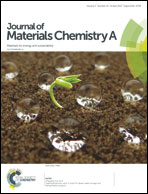Random D–A1–D–A2 terpolymers based on benzodithiophene, thiadiazole[3,4-e]isoindole-5,7-dione and thieno[3,4-c]pyrrole-4,6-dione for efficient polymer solar cells†
Abstract
Recent developments on regio-regular and random terpolymers based on a donor/acceptor architecture (D1–A–D2–A or D–A1–D–A2) have shown promising results for their use as donor materials in bulk heterojunction (BHJ) polymer solar cells. New random terpolymers including benzo[1,2-b:4,5-b′]-dithiophene (BDT) as the electron-donor moiety and thiadiazolo[3,4-e]isoindole-5,7-dione (TID) and thieno[3,4-c]pyrrole-4,6-dione (TPD) as electron-accepting moieties were synthesized by Stille cross-coupling polymerization. Incremental addition of TPD (from 0 to 90%) led to the following random terpolymers: P[(BDT-TID)x-(BDT-TPD)y]n. Their electro-optical and photovoltaic properties were investigated. These high molecular weight and highly processable random terpolymers exhibited broad and strong absorption (300–800 nm), moderate bandgaps (1.52 eV to 1.64 eV) and deep-lying HOMO/LUMO energy levels (−5.6 eV and −3.9 eV, respectively). First, the optimized inverted device ITO/ZnO/P1:PC71BM/MoO3/Ag (where P1 is a typical D/A copolymer; TID 100%; TPD 0%) showed a power conversion efficiency up to 6.36% which is higher than the PCE reported in the literature for an analog of P1 (3.42%). Then, devices based on random terpolymers (P2–P10) showed power conversion efficiencies ranging from 5.06% (for P7; 40% TID/60% TPD) up to 6.70% (for P2; 90% TID/10% TPD) when PC61PM is used as the electron acceptor. A PCE as high as 7.30%, a Voc of 0.81 V, a Jsc of 13.86 mA cm−2 and a FF of 65% were achieved for P2 when PC71PM was used. This PCE is among the highest PCE values reported for random terpolymer-based polymer solar cells.
![Graphical abstract: Random D–A1–D–A2 terpolymers based on benzodithiophene, thiadiazole[3,4-e]isoindole-5,7-dione and thieno[3,4-c]pyrrole-4,6-dione for efficient polymer solar cells](/en/Image/Get?imageInfo.ImageType=GA&imageInfo.ImageIdentifier.ManuscriptID=C7TA01467H&imageInfo.ImageIdentifier.Year=2017)


 Please wait while we load your content...
Please wait while we load your content...